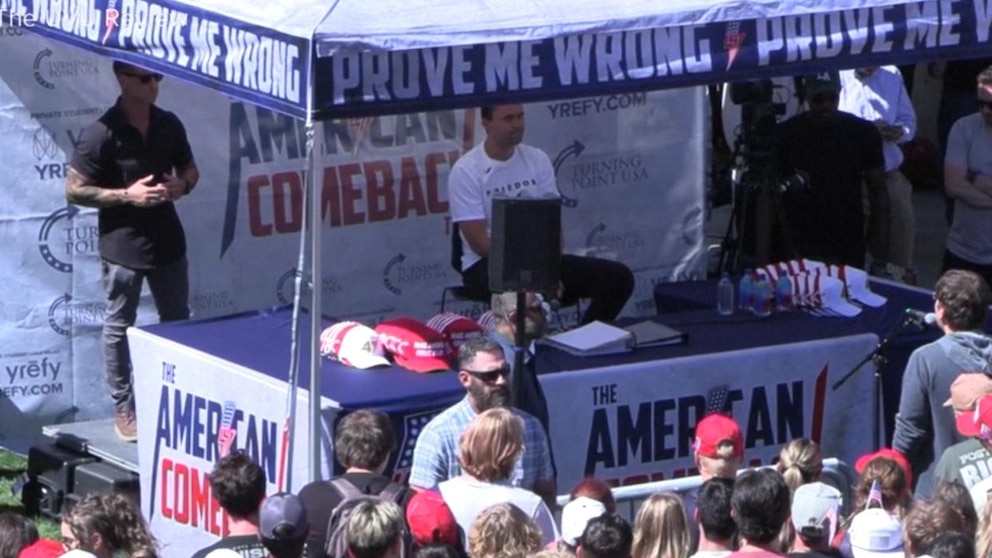“The Video No One Believed Was Real” — A Doctor Finally Speaks Out About Charlie Kirk’s Final Moments — Leaked ER Footage Reveals Details That Leave Everyone Stunned, Changing Everything We Thought We Knew — And the Reason It Was Hidden for So Long Is Leaving the Public Speechless.
It started with a whisper — a claim too bold to be true. Somewhere in a hospital on a quiet night, an unnamed doctor allegedly pressed “record.” And according to the whispers that spread across the internet like wildfire, what that camera captured inside the emergency room might change everything we thought we knew about what really happened to Charlie Kirk that day.
For weeks, the footage was said to be “nonexistent.” Officials dismissed it, experts brushed it aside, and fans were told to move on. But then — it surfaced. A grainy, twelve-second clip. The video that no one believed was real.
And now, a doctor — who says he was there — is breaking his silence.
The Night That Shook the Internet
The story began, as most modern mysteries do, with a single upload.
A user under the name @truthinplainlight posted what appeared to be hospital footage late one evening. The caption read only:
“They told us this was deleted. Watch closely.”
Within minutes, the clip exploded across social media. Hashtags surged. Millions watched, rewatched, and slowed down every frame. Some said it was Charlie Kirk being treated in an emergency room; others claimed it was an unrelated event misidentified by conspiracy channels.
The video itself was blurry — not enough to make definitive conclusions, but just enough to ignite chaos. What stood out most wasn’t what people saw… but what they
heard.
In the background, a voice — calm, professional, unmistakably that of a doctor — said something that changed the tone completely:
“This doesn’t match what they reported.”
Those six words became the center of the internet’s biggest storm.

The Doctor’s Confession
Days later, a man identifying himself as Dr. M., a supposed ER physician at the facility seen in the video, reached out anonymously through an encrypted message board.
He didn’t give his full name. He didn’t reveal his hospital. But what he said in that post sent chills down everyone’s spine:
“What you saw was real. But it’s not the whole story. The clip that’s circulating — that was never supposed to leave the hospital. It was part of an internal training file. I can’t say more… but someone wanted this buried.”
The internet pounced.
Who was this doctor?
Why would a hospital suppress its own footage?
And what did “not the whole story” really mean?
Every influencer, podcaster, and independent journalist dove headfirst into decoding the mystery. Even Candace Owens reportedly referenced the viral clip during a livestream, asking viewers:
“Why would a hospital hide footage if there was nothing to hide?”
Within hours, the phrase “ER Leak” trended worldwide.
The Anatomy of a Leak
According to online investigators, the leaked footage originated from an
internal surveillance system used in hospital trauma bays. Every major facility in the U.S. uses similar systems to review medical procedures, monitor safety, and maintain transparency.
So how could something like this “accidentally” leak?
A user claiming to work in hospital IT later suggested the file may have been copied during a software transfer, then shared through private medical networks before being downloaded and uploaded anonymously.
The hospital itself — unnamed to this day — reportedly launched an internal audit. No one officially confirmed the footage’s authenticity, but no one denied it either.
And that’s when the story took an unexpected turn.

A Pattern of Silence
For nearly two weeks after the clip surfaced, silence dominated official channels. No statements. No denials. No clarifications.
When journalists reached out to multiple healthcare administrators, most responded with one identical sentence:
“We have no record of any incident matching that description.”
But the internet doesn’t wait for confirmation — it investigates.
Independent analysts slowed down the footage frame by frame, using contrast filters and motion mapping to identify environmental clues. Some claimed they could make out familiar hospital signage. Others argued it was a composite of different clips.
One particularly chilling moment — a shadow moving in the background — became the focus of intense debate.
Was it another medical staffer? A reflection? Or something the camera wasn’t supposed to capture?
No one could say for certain. But the lack of answers only made the mystery grow.

The Doctor Speaks Again
A week after his first message, Dr. M resurfaced. This time, he didn’t post on an anonymous board — he emailed a journalist under strict conditions of confidentiality.
He wrote:
“The reason the footage stayed hidden isn’t because of what it shows… it’s because of what it proves. Protocols were broken that night. People made choices that contradicted the official procedure. If the public saw the full version, they’d realize how many corners were cut. That’s all I can say.”
That message reignited everything.
Now it wasn’t just about Charlie Kirk or the clip — it was about accountability, transparency, and trust in the systems designed to protect the truth.
The Media Divide
Mainstream media outlets approached the story cautiously. Some labeled it “digital misinformation,” while others acknowledged that the clip’s origins remained “unverified but compelling.”
Meanwhile, online commentators refused to let go.
One podcaster summed it up perfectly:
“Even if this clip isn’t what it seems, the reaction proves something bigger — people don’t trust what they’re told anymore.”
The debate split into two camps:
-
The Believers — who argue that the leaked video exposes inconsistencies in the official timeline.
-
The Skeptics — who say the clip was manipulated to stir outrage and clicks.
But in between the noise, one question lingered:
Who benefits from hiding the truth?
The Footage Re-Examined
When digital forensics experts finally reviewed the viral clip, their conclusions only deepened the mystery.
They confirmed that no digital editing markers were detected — meaning the footage hadn’t been tampered with. However, they also noted that the timestamp appeared corrupted, suggesting it may have been copied or recorded from a secondary source.
One expert noted:
“The lighting, reflections, and movement are consistent with authentic ER surveillance. What’s unusual is the audio — it’s too clean, as if overdubbed.”
Could someone have added the doctor’s voice later to frame a narrative? Or was the voice part of the original environment, captured unintentionally?
That unanswered question became the dividing line between truth and illusion.
The Whistleblower’s Gamble
By the third week, the supposed doctor’s identity began to narrow. Internet sleuths found patterns in his language that matched a Texas-based trauma specialist. Still, no publication revealed a name — partly due to ethical concerns, partly out of fear of litigation.
An editorial from an independent news outlet summarized it best:
“Whether the doctor is real or not, what he represents is the growing desperation for honesty in a world where everything is filtered, approved, and controlled.”
In his final message before vanishing from all contact, Dr. M left one haunting line:
“You’ll know the truth when you stop being told what to see.”
The Public Reaction
What began as a small, suspicious upload had now become a cultural earthquake.
Twitter threads turned into documentaries. YouTubers built hour-long breakdowns. TikTok detectives pointed out “clues” hidden in the video — reflections, monitors, unidentified figures in the corner of the frame.
And yet, with every new theory, the core mystery remained unchanged:
Why was this footage hidden?
A quiet consensus began to form among viewers. Maybe it wasn’t about Charlie Kirk at all. Maybe it was about something bigger — how the truth itself can vanish behind red tape, algorithms, and official statements.
Inside the Hospital Walls
Anonymous nurses began sharing cryptic posts online — messages about “files locked after midnight” and “security warnings sent to staff.” While none directly referenced the viral clip, the timing was too close to ignore.
One message read:
“We were told not to talk about it. Not because it was fake — but because it was complicated.”
That one sentence reignited public fury.
If there was nothing to hide, why would staff be silenced?
What the Experts Say
Media experts and psychologists began analyzing the phenomenon from another angle — the emotional grip of digital mysteries.
Dr. Helen Voss, a communications professor, explained:
“When information is restricted, the human brain fills in the blanks. It’s not about whether the footage is real — it’s about the collective experience of trying to uncover something forbidden.”
Others compared it to modern myth-making. The story of the “leaked ER video” had become less about the footage itself and more about what it represented — the public’s hunger for truth in an age of curated narratives.
The Official Word (or Lack Thereof)
Eventually, a short statement appeared from a hospital spokesperson:
“We are aware of a circulating video purporting to show a medical emergency. At this time, we cannot confirm its authenticity or relation to any known patient event. We urge the public not to spread unverified material.”
But for many, that only raised more questions.
If the footage was fake — why not say so directly?
If it was real — why avoid mentioning the details?
The silence was deafening.
The Vanishing Clip
Then, almost overnight, the clip began disappearing.
First from TikTok. Then X. Then Reddit threads vanished. Links returned 404 errors. Accounts were deleted. The hashtags went quiet.
Conspiracy forums called it a “digital erasure.” Others said it was standard moderation against unverified content. But the effect was the same — the footage that had once dominated every feed was suddenly gone.
And yet, like every deleted video in the internet age, fragments survived — reposted, mirrored, and downloaded by thousands determined to preserve it.
One user wrote:
“You can delete the file, but not the questions.”
The Human Element
At the heart of the storm was a simple, sobering truth: millions of people felt emotionally invested in a story they didn’t fully understand.
Whether they believed the video showed something real or staged, everyone was united by one thing — a shared sense that something about the official explanations didn’t add up.
It wasn’t just about one man or one clip anymore. It was about how truth gets filtered through the lenses of power, media, and fear.
The Unfinished Story
Weeks later, discussions continue.
Podcasts dissect every frame. New witnesses claim to have seen “the original unedited version.” But the supposed doctor — the man who started it all — remains silent.
And yet, his words echo in every comment thread, every theory, every headline:
“You’ll know the truth when you stop being told what to see.”
Was the video real?
Was it altered?
Or was it something else entirely — a reflection of how we now process truth in the age of virality?
Whatever the case, the story of the “video no one believed was real” has left one undeniable mark:
It forced millions to question not just what they saw, but what they were allowed to see.
The Truth in the Blur
In the end, maybe that’s what makes this story unforgettable.
A 12-second clip. A doctor who risked everything. A mystery that refuses to die.
No matter where you stand — believer or skeptic — one thing is clear:
the search for truth has never been more powerful, or more dangerous.
And somewhere, hidden deep within a server or a conscience, the full footage still exists — waiting for the world to be ready to see it.

